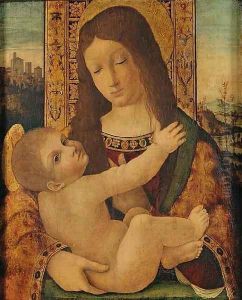Ambrogio Stefani Da Fossano Borgognone Paintings
Ambrogio Stefani da Fossano, also known as Ambrogio Borgognone, was an Italian painter of the Renaissance period, active mainly in Milan. He was born in Fossano, Piedmont, around 1453. Despite being often called Borgognone, which suggests a Burgundian origin, recent scholarship has confirmed his birthplace as Fossano. Borgognone's style is characterized by its devotional quality, refined color palette, and delicate attention to detail, which reflects the influence of Northern European painting and the Lombard artistic environment of the time.
Borgognone's early life and training remain somewhat obscure, but it is believed that he may have been a pupil of the painter Vincenzo Foppa. His works indicate that he was also influenced by the stylistic trends of Northern Italy and the detailed work of the Flemish school, which was known for its precision and naturalism. Borgognone's art was primarily religious in nature, and he was particularly adept at creating altarpieces and frescoes for churches and convents.
One of Borgognone's most significant works is the fresco cycle in the Certosa di Pavia, a monastery near Milan, which he began around 1486 and continued to work on for several years. These frescoes demonstrate his mastery of color and composition, as well as his ability to convey spiritual themes with a sense of realism and humanity. His altarpieces, often featuring the Madonna and Child, saints, and angels, are also highly regarded for their serene beauty and delicate modeling.
Borgognone's influence on the Milanese school was considerable, and he played a role in the development of Lombard painting. His works were known for their piety and a certain austerity, setting them apart from the more ostentatious styles that were popular in other Italian regions during the High Renaissance. Despite the evolution of more dramatic and grandiose styles, Borgognone's paintings remained sought after by a clientele that appreciated his contemplative and serene approach to religious art.
Ambrogio Borgognone's contributions to Italian Renaissance art continued until his death in 1523 in Milan. Throughout his career, he maintained a consistent style that resonated with the devotional practices of his time. His legacy is preserved in the many works that survive in churches, museums, and collections, serving as a testament to his skill and devotion to the spiritual expression through art.
